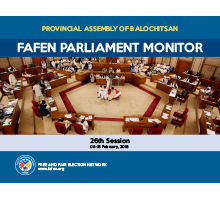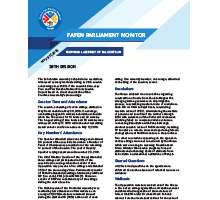25 MPAs remain inactive during 27th session of Balochistan Assembly
ISLAMABAD: Twenty-five lawmakers did not take part in any of the proceedings during 27th session of the Balochistan Assembly that adopted 10 resolutions and passed one bill amid low attendance, says Free and Fair Election Network (FAFEN) in its Session Report.
The session, comprising seven sittings, started on March 26 and ended on April 11, 2016. The session was marked by low attendance of lawmakers as on average 19 (30%) members remained present during the start and 18 (28%) at the end of each sitting. One minority member, on average, attended each sitting of the session.
On average, each sitting started 35 minutes behind the schedule and lasted 142 minutes. The longest sitting of 2 hours and 32 minutes was witnessed on March 29, 2016 while the shortest sitting lasted 45 minutes on April 11, 2016.
The most striking part of the session was the disinterest shown by 25 lawmakers in the proceedings of the House. Among the non-participating members, 12 belonged to PML-N, followed by JUI-F (4), NP and PML (3 each) and one each of PkMAP and BNP-A. The only independent lawmaker in the provincial assembly also remained inactive during the session.
FAFEN observes lawmakers’ participation against three categories; members who only submit agenda on the Orders of the Day, lawmakers who take part in the debate and the legislators who both submit agenda and take part in the on-floor discussion.
Six (9%) members submitted the agenda items, 14 (22%) lawmakers took part in the debates while 19 (30%) legislators submitted both the agenda items and took part in debates. Thirteen PkMAP lawmakers enthusiastically participated in the session, followed by NP and PML-N (8 each), JUI-F (4), PML and BNP (2 each), and one each of ANP and MWM. The female lawmakers remained more active in terms of taking part in the debates and submitting agenda items, besides participating in 92 percent of the proceedings. In comparison, their male counterparts only participated in 54 percent of the proceedings.
The main focus of the lawmakers during the session remained security and development. They also demanded execution of the quota apportioned for Balochistan in the energy and power sectors. The legislators, by sponsoring resolutions,called for development of agricultural sector in the province, stressed the need for constructing small dams, demanded provision of training on drip irrigation process and pleaded for less load-shedding of electricity for the agriculturalists. The House did not witness heavy legislative business during the session as it passed only one treasury backed bill – the Balochistan Witness Protection Bill, 2015 – that aimed to ensure protection for witnesses and avoid revealing their identity in serious criminal cases.
The Provincial Assembly adopted six out of 10 resolutions appearing on the agenda. The adopted resolutions included minimization of load-shedding hours to benefit farmer community, making provincial Art Gallery useful for the youth, providing additional electricity to various districts, construction of small dams to store rain water and formally declaring Ziarat as a Tourism Zone.
A resolution against involvement of Indian secret agency Research and Analysis Wing (RAW) in spreading terrorism activities in the province was also adopted by the House during the session that was initially submitted as an Adjournment Motion by the Leader of the Opposition.
Two resolutions urging the provincial government to give one month salary to government employees as bonus on religious festivals and allocation of funds for establishment of new colleges for girls were rejected by the House while another two resolutions pertaining to provision of funds for construction of road from Zob to Mughal Kot and training of farmers on drip irrigation process were deferred during the aforementioned session.
The House observed question hour in three sittings and lawmakers raised 26 questions addressed to different departments. Eleven starred questions were taken up on the floor of the House and responded to by the relevant ministers. Fifteen other questions remained unaddressed due to the absence of government representatives or their movers.
The Speaker attended all seven sittings and chaired 75 percent of the session’s time while a Member of Panel of Chairpersons presided over the remaining 25 percent of the session. The post of Deputy Speaker is still lying vacant since December 23, 2015.
The Chief Minister (Leader of the House) attended two sittings and participated in 26% of the session’s proceedings while the Leader of the Opposition was present in three sittings and attended 43% of the proceedings time. Parliamentary leaders of PkMAP and PML attended five sittings, followed by ANP and MWM (4 each) and NP (2). However, Leader of BNP did not attend any of the sittings during the entire session.
The session witnessed an incident of token walkout by JUI-F member during 5th sitting for non-inclusion of the Adjournment Motion sponsored by the Opposition Leader.Another two incidents of walkout were staged by the entire opposition and a female member belonging to NP against the Speaker for rejecting the Adjournment Motion with majority votes that consumed 54 minutes of the proceedings.
Three reports, including one government and two of the standing committees, were presented before the House during the session. These included reports on the Balochistan Witness Protection Bill, 2015, the second Bi-Annually Monitoring Report of National Finance Commission and the Standing Committee on Rules of Procedure and Privilege on proposed amendment to the Rules of Procedure and Conduct of Business for formation of Council of Chairmen and the Standing Committee on Implementation of Resolutions.
Lawmakers raised 39 Points of Order (POs) that consumed 164 minutes of the session time. Moreover, one adjournment motion out of two appearing on the list of business was admitted for discussion while the other was rejected by the House.
To download complete report, click here




